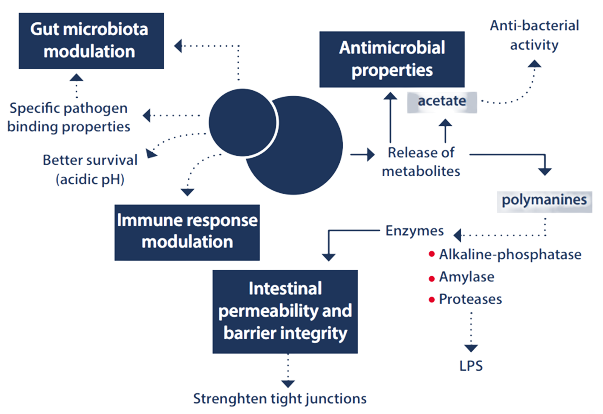Blog | Reading Time 2 minutes
Not all yeasts are equal: what makes Saccharomyces cerevisiae var. boulardii so unique?
Discovered just a century ago by Dr. Henri Boulard in Vietnam, the yeast Saccharomyces cerevisiae var. boulardii is today the most documented and widely used probiotic in human medicine and animal nutrition. Its benefits on gut health and feed digestibility are undeniable.
What do we know about this specific yeast that makes it so unique?
Unique structure
First, S. c. var. boulardii is part of the large S. cerevisiae species. When compared to other S. cerevisiae yeast, S. c. var. boulardii has a distinctive shape and characteristics:
- It can grow under both aerobic and anaerobic conditions.
- It harbors a thicker cell wall than other S. cerevisiae. It is resistant to bile acids and to gastric pH.
- It survives well in the conditions of the gastrointestinal tract.
- Due to its specific cell wall structure, S. boulardii exhibits an interesting pathogen binding capacity.
Highly functional metabolites
It has been proven that Saccharomyces cerevisiae var. boulardii produces specific metabolites of great interest towards undesirable bacteria and their toxins, as well as supports the host’s immune response. For instance:
- Antimicrobial and antitoxin peptides, such as a protease which is able to inhibit the binding of C. difficile toxin A and B to specific intestinal receptors.
- Acetate: New studies have shown S. c. boulardii CNCM I-1079 has the unique ability to produce high levels of acetic acid (about 7g/L). Acetic acid can induce antimicrobial properties thanks to its anti-bacterial activity and represents a substrate for gut microflora populations that produce butyrate.
- Polyamines: S. boulardii secretes polyamines, which play a role in gut maturation and regeneration (e.g. enhancement of the brush-border enzymes that have, among other effects, a crucial role in the energy intake process).
- Unique set of enzymes: Alkaline phosphatase plays a part in the dephosphorylation of bacterial LPS, amylase, sucrase, glucoamylase, and n-aminopeptidase.
Our unique S. boulardii CNCM I-1079 yeast strain is supported by more than 60 dedicated publications. It is available in a unique microencapsulated form, TITAN, for inclusion into various feed forms, including pelleted feed.
Published Oct 2, 2023
Related articles
Need specific information?
Talk to an expert